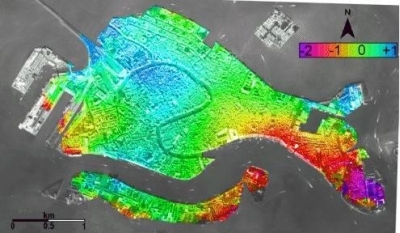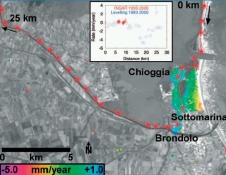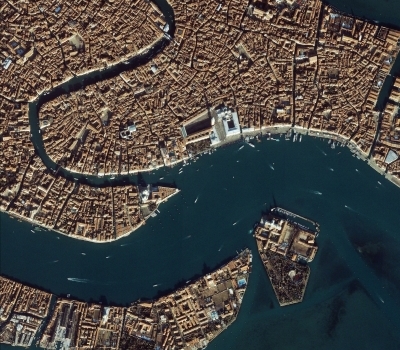Teledetectie van sites behorend tot het cultureel erfgoed
Venetië, Italië (in het Engels) (2/2)
Contribution of Remote Sensing
From 2001 to 2003 ESA's VENEZIA project was carried out with goal the to implement a land subsidence monitoring service in the Lagoon of Venice for regional administrative and water authorities. An important element of the project is the integration of SAR-based monitoring techniques with levelling and GPS surveys into an overall database and information system capable to provide the best knowledge of the subsidence process to the authorities that manage the Po Plain area around the Lagoon of Venice.
In the lagoon of Venice, traditionally subsidence rates are monitored with varying temporal and spatial frequency depending on the ground measurement networks.
The use of satellite derived subsidence measurements helps to improve the spatial and temporal frequency to every 25m and at least 35 days (repeat pass orbits in the case of ERS and ASAR) in the case of DInSAR and IPTA. The combination of ground and satellite measurements helps to confirm the accuracy and cross validation of the satellite derived measurements as well as providing improved and more detailed maps of subsidence in the Lagoon and surrounding area.
The image below is a juxtaposition of old and new data that shows the subsidence changes. An aerial or satellite picture of Venice (black and white) is overlaid with the current data of the earth reconnaissance satellite (colored). The space data show that part of Venice is sinking millimetre by millimetre into the sea - more in the red and violet areas than in the blue and green. Such details help concentrate structural protection measures in the places where they are most needed.
As it can be observed in the figures for two specific areas around the Lagoon of Venice, SAR interferometry exhibits complementary characteristics to the levelling surveys, because it has the capability to map urban areas at high spatial resolution. In particular, SAR interferometry is very useful to perform detailed investigations in coastal areas: in Chioggia and Jesolo a significant seaward gradient in land subsidence, practically impossible to be detected by other traditional monitoring techniques like geometric leveling and differential GPS, is visible. A critical situation is also observed in Eraclea, where the sinking velocity reaches 4 mm/year. The high precision levelling surveys, on the other hand, are used outside of the cities, as to the east of Chioggia, and to set up a reference point for the SAR subsidence values. The high accuracy of the two surveying techniques is confirmed by their cross-validation along the levelling lines.
The study demonstrates that the central lagoon, including the city of Venice, shows a general stability while the northern and southern lagoon extremities and their related catchment sectors sink with serious rates averaging 3 to 5 mm/year.
The sinking rates increase up to 10-15 mm/year in the coastland south of the lagoon. Relatively small uplifts (less than 1 mm/year) are observed at the Alpine foothills and in a wide area comprised between the Euganean Hills and the lagoon.
The observed land displacements have been associated to the geological features of the study region, i.e. tectonics, seismicity, differential consolidation of the middle-upper Pleistocene and Holocene deposits, and to anthropogenic activities, such as land reclamation and groundwater withdrawal.
Results of the project prove that this integration in the knowledge of the subsidence process can be efficiently obtained for both a back analysis during the last decade and future monitoring of evolutionary trends. The acquisition of these physical environmental characteristics is at present necessary for urgent restoring works and conserving plans of the lagoon's ecosystem. In future, knowledge of land subsidence may assist potential exploitations of the underground resources, i.e. water in coastal and catchment areas and gas off the littoral.




